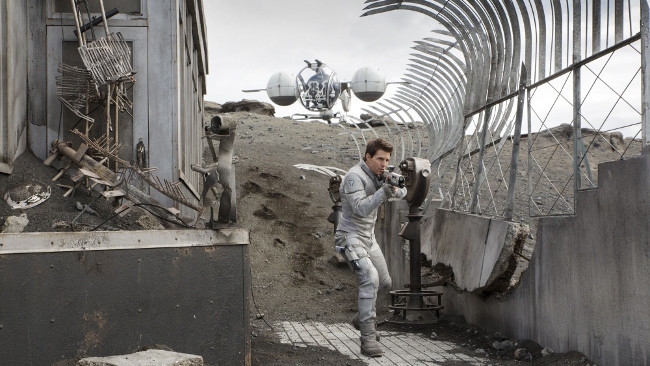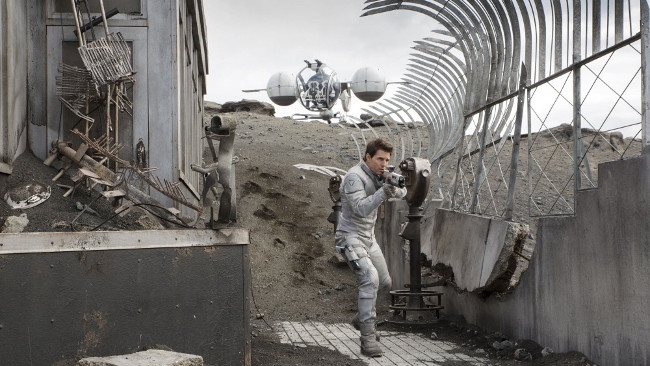
 Still from the 2012 motion picture Obilvion starring Tom Cruise
Still from the 2012 motion picture Obilvion starring Tom Cruise
We breakdown the digital workflow of the 2012 blockbuster Oblivion, from camera choice to home distribution.
In a Reader's Comment to a recent RedShark article, 'Don't go Abandoning HD Just Yet' by David Shapton, I claimed that the 2012 film Oblivion was one of the sharpest and best presented HD Blu-ray movies I had ever seen. I assumed that the workflow from 'on set' to 'TV set' for that film must have been particularly well planned, so I want to investigate how Oblivion managed to deliver such a satisfying picture experience to both cinema viewers and dedicated 'home theatre' consumers alike, via a medium which is inherently a heavily compressed, 8-bit, 4:2:0 consumer format.
Origins and camera choice
The concept behind the movie Oblivion was hatched by Writer/Director Joseph Kosinski after the success of his futuristic first film, Tron: Legacy. For that 2011 film, Kosinski had partnered with DoP Claudio Miranda ASC, who shot Tron digitally on Sony's F35 camera. Miranda also has a passion for creating, for the most part, as much of the 'look' of a film in-camera, rather than relying on heavy CGI in postproduction.
In late 2011, Sony released its latest F65 CineAlta camera, but for their Oblivion collaboration, Kosinki and Miranda tested several camera options: "Sony cameras definitely have a particular look, one that's a little cooler than, say, the Arri Alexa, and Joe really loves that look. He liked what the F35 gave us on Tron and he was really a fan of the F65 in our tests for Oblivion."
Miranda added: "So, we ended up being some of the first guinea pigs for the F65 in a production scenario!" He continued, "It gives you a fantastic image, but it's a large camera, and the ergonomics aren't necessarily the most user friendly. When we wanted to put body mounts on Tom Cruise or do quick Steadicam moves, we used Red Epics instead. But about 98 percent of the movie was shot with the F65." And it was shot at 4K resolution. As anybody who has shot 4K today will know, the challenging data rates demand the very best in set management and data storage regimes. Add a RAW workflow into the mix and the team required off set assistance from a third party digital workflow specialist, Technicolor's FrameLogic™ system.
Finding glass
Once their choice of camera was finalised, Miranda and his crew set about testing lenses which would allow them to work at the extremely large apertures they would need to realise their plan: to film under the available light offered by using an old Hollywood technique of front projection, but in a totally new way. A full set of Arri Master Primes were furnished, as well a several Fujinon Premier Zooms. Miranda commented in an ASC interview:
"We considered shooting anamorphic, but I wanted to use faster lenses. We used the Master Primes for most of our work, but the Fujinon [Premier] zooms were very impressive. We used them for crane work and helicopter work, just to make sure we had a good variety of focal lengths. When I did side-by-side lens tests in prep, I found the Fujinons are actually sharper than the Master Primes, which was hard to believe! We had all four of them: 14.5-45mm [T2], 18-85mm [T2], 24-180mm [T2.6] and 75-400 [T2.8]. A couple of shots called for a telescope point-of-view, and we put a doubler on the 75-400mm, giving me an 800mm. I couldn't believe how sharp it was."
4K RAW post
OK, so we have acquisition well sorted. What about the RAW 4K Post workflow? Technicolor's FrameLogic™ system was installed in a customized trailer designed to travel with the production throughout Louisiana and Mammoth for near instant dailies viewing, just steps away from the project's many locations. Technicolor also provided the same technology to the production inside its own Manhattan facility, when the movie was shooting in New York, and inside a third-party facility, when it was shooting in Iceland.
Co-Producer on Oblivion, Steve Gaub explains: "We did not want to ship F65 cards from one place to another in Louisiana. We talked about setting up a suite near the stage, as they often do with this technology, but not all of our work was near that stage. That can interrupt the immediacy of dailies. So we wanted to make sure we had a way to process and color correct dailies and view them in a calibrated screening room wherever we went. Technicolor calculated what equipment we needed for the trailer and how many guys, and made it so that we could screen dailies during lunch, no matter where we were. That gave our cinematographer [Claudio Miranda, ASC] the ability to see right away if he had what he needed. It was very much like having the lab right next door."
The Technicolor system simplified the film's daunting workflow. Technicolor's VP of Location Services, Dave Waters explains: "Given the rapid technological and format changes in the industry, for instance, Technicolor also built FrameLogic™ to allow producers to future proof material with 4Kcapabilities by building into it 4K/16-bit industry standard ACES workflow compatibility (which is growing in importance in the industry with the advent of 4K cameras like the F65). In fact, company officials say the production of 4K/ACES television programs using the F65 camera and built around the notion of creating high-end masters compatible with 4K viewing devices of the future are already starting to happen around the industry, and one of them, at press time, had indeed chosen the FrameLogic system for dailies' work."
"We had our screening room in the trailer Cosmic Post, Inc. built for us, and the Technicolor team processing dailies in that trailer," elaborates co-producer Steve Gaub. "Any time that Claudio Miranda saw something he wanted to re-time, he didn't have to wait until evening or the next morning or weekend. The dailies team was right next to the stage with us. In all those cases though, Claudio, having done many digital shows, got to do, as he prefers, much of his color work downstream of the digital intermediate. He is a cinematographer who prefers to set a few broad LUTs and not have to manage the color setup by setup. So there was no reason for him to have the dailies team on set, but he had them nearby, in a comfortable environment with great screening capabilities, where he could rapidly and seamlessly make any changes he required. The whole system was agnostic and flexible. It was not constricted—it was pliable. And that is why, especially since we were using a brand new camera technology, we wanted to go with Technicolor's approach to the dailies problem."
[Ed Note: For more on Technicolor's role in post for Obilivon, download the PDF from Technicolor by clicking HERE.]
Mastering and exhibition
Much of Oblivion's Post Production was completed at Skywalker Ranch in Marin County, California, but when it comes to watching Oblivion at home, my RedShark comment specifically mentioned a 'Mastered in 4K' BluRay disc. This is not an Ultra HD BluRay, but a normal 1920x1080 HD BluRay running at 24fps Progressive rather than the usual 50i/60i interlaced BD standard. For the disk to carry the 'Mastered in 4K' banner, it also needs to satisfy several specific criterion and to quote from an Australian C|NET review:
"There are three technical measures that elevate a "mastered in 4K" disc above the rest:
· Enhanced bitrate: these discs exclude content extras in favour of using all available disc space to deliver the film in a greatly enhanced bitrate. Where most Blu-ray discs are typically delivered in rates in the 24Mbps to 30Mbps ballpark, these "mastered in 4K" discs deliver at 35Mbps to 38Mbps. A greater bitrate means a much clearer picture, and less moments where blocking or blurring will occur, particularly in action sequences.
· XvYCC support: in the Blu-ray standard, xvYCC (also known as x.v.Color) is a colour space option that to date, has almost never been supported. XvYCC extends the available colour gamut to better represent the colour space that the original film was intended to be displayed at, while the standard sRGB space cuts off a lot of information in the red and blue-green sections of the spectrum. As long as your Blu-ray player and your TV support xvYCC, these discs will deliver a solid colour enhancement over other discs on the market.
· Sony 4K algorithms: this final feature is a sweetener focused on giving Sony 4K TV owners a better experience with these discs than any other 4K TV owners. Being part of the same family, Sony Pictures and Sony Bravia have shared proprietary algorithm information to give the best possible upscaling performance on these films. Sony 4K televisions will be able to identify a "mastered in 4K" disc and use an upscaling algorithm based on the same formula used at Sony Pictures to downscale the film from 4K to HD. This secret sauce is likely to give a Sony TV the edge over other TVs that must use less-specific algorithms to upscale the content.
In our case, the Oblivion Mastered in 4K BluRay disc was displayed on one of the latest Sony BD players to support the xvYC colour space and connected to our calibrated 55" Sony X9005B 4K Bravia 'client monitor' via a short HDMI 2.0 cable. This monitor is also capable of displaying 4:4:4 PC graphics at upto 60P in 4K when correctly configured.
End-to-end Sony
In summing up, we had a digital workflow largely dominated by Sony technology: from a Sony Pictures movie called Oblivion, shot on their premier F65 CineAlta camera with a 4K RAW workflow to an initial 2K Cinema DCP and subsequent 4K Master, then to a special, high bitrate BD x.v.Color duplication and, finally, to a Sony BluRay player where the disc is running at 24P and the x.v.Color signal is connected to a Sony 4K Bravia UHD TV, which correctly interprets the HDMI 2.0 signal to upscale the high bitrate HD algorithms to UHD in real time.
All-in-all, this demonstration of Oblivion displayed in upscaled HD was a very satisfying experience. However, few of us have access to this level of technology from concept to completion, but as film makers, our job is to make sure that every part of our particular video jigsaw puzzle falls into exactly the right place, if we want our final results to be visually stunning.
Tags: Production


Comments